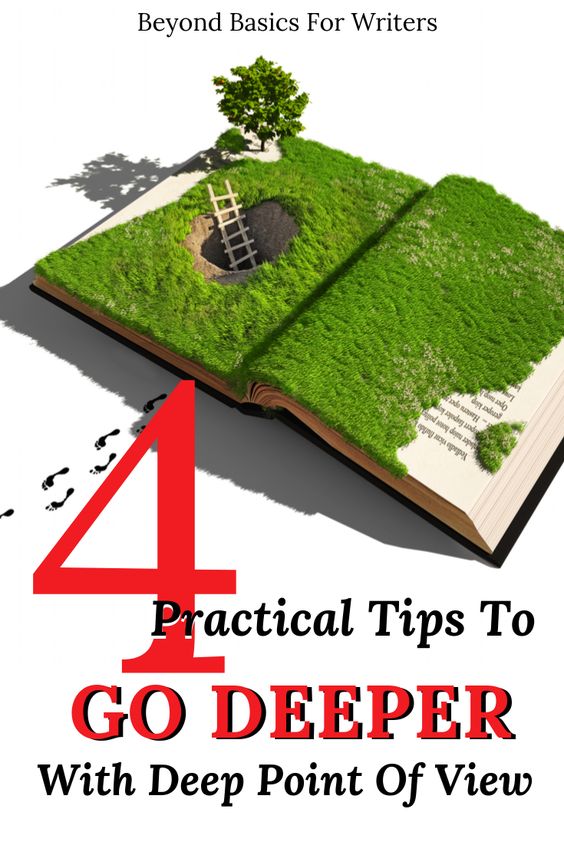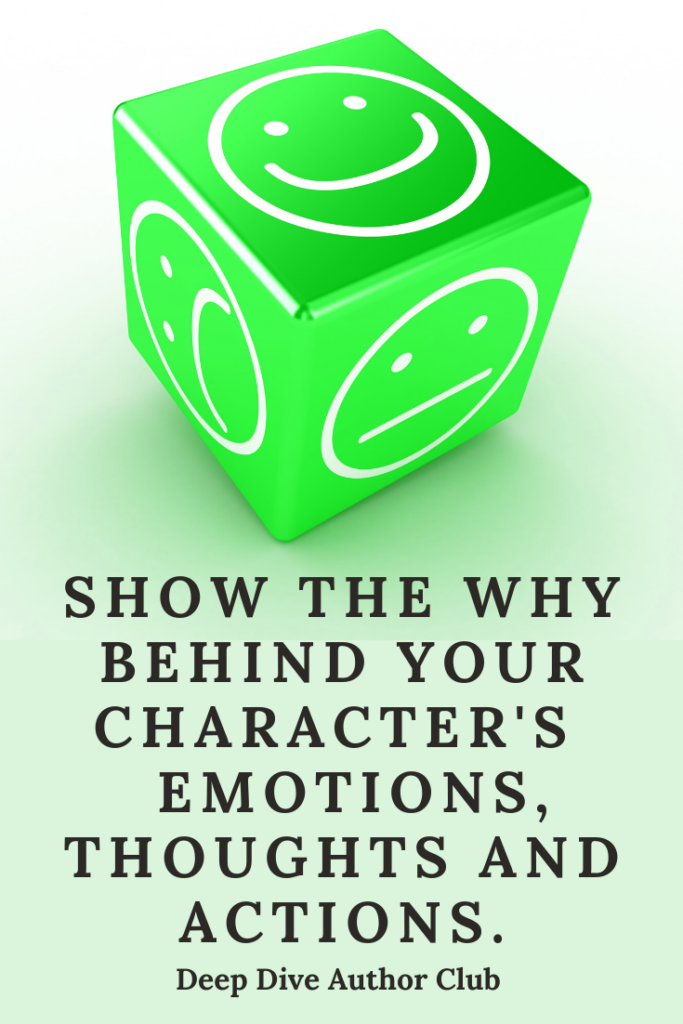
In deep point of view, we want to use beats instead of dialogue tags to attribute dialogue. Beats move the story ahead, they are more efficient, keep the reader deep inside the character’s head, and remove the writer/narrator voice. In limited third person, dialogue tags are encouraged (he said/she said), but they aren’t used much (or preferably at all) in deep point of view.
“Hand me that bowl,” Edith said. (dialogue tag)
“Hand me that bowl.” Edith waved her finger at the large red bowl on the top shelf. (action beat)
Action Beats
It’s a pretty easy switch to replace dialogue tags with some movement or action by the character speaking. This is known as an action beat, but if all you’re doing with that action is attributing dialogue it’s a stage direction. Stage directions have their place, but in deep point of view you want to use stage directions sparingly and instead challenge yourself to ensure every word moves the story ahead. Your action beats should also show emotion, or motivation, or priorities, etc. AS WELL AS attribute dialogue.
“Hand me that bowl.” Edith waved her finger at the top shelf. “The red one.”
“Hand me that bowl.” Edith stabbed the air towards the top shelf with a stiff finger and raised her voice. “The red one!”
For an action beat to do all of this, dig deeper than stuffing hands in pockets, running hands through their hair, or moving from stage right to stage left. Really be aware of the emotions the character is struggling with (both those they’re willing to let people see and those they’re trying to hide) and then add movements or gestures that reflect their emotions, their inner turmoil, angst, hopes, etc.
Jan sat and bounced back up out of her chair to pace. “But I really like him and he doesn’t even know I exist.”

Physical Sensations: Internal and External
There are internal physical sensations and external ones and these can be used to attribute dialogue as well. Both work well for powerful beats to convey emotion and move the story along.
Heart rate is an internal sensation. The sting of crushing snow in your bare palm is an external sensation.
Emotions are FELT inside the body, so google the emotion you want to convey and work with the physical symptoms. Consider flushed skin, heart rate, constricted throat, tense muscles, quivering muscles, numbness, sensitivity, tingles, shivers, prickles, stinging, etc. Various aches and constricting – throat, gut, shoulders, back, lower abdomen, thighs, hands, etc. show emotion or emotion withheld. Whether these parts ache, or squeeze, twist, have stabbing pains, get tense, or throb – they can all show how a character feels, what they want to do, etc.
Where do they carry tension or hold emotion? Where a character carries their tension can tattle on the kind of tension they carry. A tight and clenched throat often hints at words that are swallowed or stamped down, or some deep emotion (from the past) that’s kept under control though it wants to burst forth.
Choose verbs that convey emotion intentionally and strategically. Do shivers creep up their arms, or rattle their spine? Is there a stiff breeze or a chilly draft? Is it raining or humid, how does that make their skin feel? Are their clothes too tight, too loose, wet, bunching – what draws their attention to their discomfort? The character’s perception of these things can all be used to show how a they feel or show the WHY behind a decision.
Shannon sank her toes deeper into the icy sand and cracked her neck. “I can do this.”
Shannon swallowed around the lump clogging her throat and pressed her shaking fingers against her belly. “I can do this.”
Setting Beats
A character’s perception of the setting can be used as a beat. Remember, it’s all about how the character perceives what they take in – do they feel encouraged, set upon, beat up, blocked – how can the natural world around them or the physical setting show this?
“So you’re leaving? There’s no changing your mind?” Steve leaned against the faded pencil marks on the doorframe that had tracked their childrens’ growth over the years that now seemed more like a countdown clock to this moment.
“I don’t believe you. He was fine this morning. I kissed him goodbye.” Cynthia glanced out the window and the last leaf let go on the maple Joe had planted, scattered to winter’s coming chill.
Tone Of Voice
I find this one is very effective, but often overlooked as a beat. Tone of voice shows us so much about how a character feels. The actual meaning of the words we speak are only one third of the information we take in when deciphering communication: meaning of words, body language, tone of voice.
She couldn’t keep the quiver from her voice. “Everything is my fault.”
Steve crouched down to the child’s eye-level and forced some cheer into his voice. “I’m home now. Still wanna play?”
This is also effective when the POV character is interpreting what others are saying to them. Consider these examples. Barric is NOT the POV character in any of these sentences, but the POV character is taking in more than just his words to interpret the meaning of what he’s communicating.
“Well, you’re stuck with me.” Barric didn’t raise his voice. Like he wasn’t mad at all. “We don’t get to choose our families.”
“Edric was doing his job.” Barric’s tone grew sharper and his accent more pronounced than it had been. “Don’t find meaning in actions where none was intended.”
Internal Dialogue
Yes, you can use a thought as a beat. In deep POV, italics or he/she thought tags are avoided and beats used to attribute thoughts as well. Some writers *I think* fear that if they don’t tell the reader the character is thinking they won’t know thoughts from narrative, but in deep pov all of it comes from the POV character. Thoughts, when used well, can be very effective beats.
“Why are you doing this to me?” Lynna had told him the truth and he was still saying no. (Lynna is the POV character)
Unique To Your Character Or Storyworld
Many of us have “tells” that tattle on the emotion we’re feeling or even trying to hide. Does your character have a tick or a specific mannerism that readers will associate with a specific emotion? Do they twist buttons, or pick at loose threads, or bite their lip? Are there any objects they carry or have at hand to help them stay calm or find motivation?
Sara wiped the blood off her sword and stood straight. “I’m fine.”
Judy perked up her antennae but nothing seemed out of the ordinary. “All clear, Captain.”
Using Subtext
The above beats, when used strategically, are very effective. But challenge yourself to go even deeper! Try using subtext to replace dialogue between people who know each other well. (read more about replacing dialogue with subtext here).
Steve caught Marcy’s gaze, tapped his watch, and lifted his brows. “It’s ten o’clock.”
Marcy threw him that saucy smile of hers, and then turned her back on him and kept right on talking.
Complex Beats
Try combining two of the above ideas to create a nuanced beat that really pulls readers in and grabs them by the throat. Go deeper than an internal sensory beat (a racing heart or trembling fingers) and also incorporate internal dialogue or metaphor to add depth and realism. The goal is for the reader to feel like they’re right there in the room, inside the character’s head, in their skin almost. Show what they’re feeling!
“There’s been some mistake. I’m Joe.” He straightened to his full height and looked down on the girl.
This example uses dialogue, an action beat, and subtext to show emotion.
Stacy’s heart pounded against her ribs like a wrongly-convicted prisoner behind bars “You’re Charlie. I heard you give that name to the maitre-D.”
This beat uses an internal sensation and a metaphor.
You’ll notice that I haven’t included stating emotions in any of the beats. That’s because in deep POV, using emotion words (most of the time) is considered telling. It’s fine if you’re writing limited third person, but the goal is to eliminate the author/narrator voice in deep POV. The following types of beats would be considered telling in deep POV, but perfectly acceptable in limited third person:
“Steve, you came!” Natalie bounced on her toes and clenched her hands against the nervous flutter.
Mark stamped his foot in anger. “I’m not going!”
What other beat-creation tips do you use when writing in deep POV?


Thanks for this post, Lisa. The timing is perfect. I’ve not done much writing since I released my last book in October 2019 (major burnout) and then came Covid (nasty, rotten scoundrel). I only recently rewrote a novella I’d written years ago, and it still needs work. The first thing I do is add emotion, reactions to setting, dialogue beats, etc., all in deep POV.
It’s been awhile since I’ve entered the editing stage, so this post was a much welcomed refresher, and had some great examples of how it’s done. THANK YOU!
Stay safe and well,
Susan Haught
Glad you found it helpful!
Wow these examples are so well written! I gleaned so much information and context and emotion from them and they were so much richer than the example in limited 3rd person POV. I love how so much information, subtext, undercurrents, tension, and background can be conveyed when eliminating emotion words. It really forces you to focus on describing the scene and knowing your character well in order to write.
Thanks for these examples!
Yes! Part of why I love deep POV is the mental challenge of capturing everything with enough authenticity that the reader feels like they’re IN the story.
Great article, Lisa. Printing it for reference. Barb
Awesome. Hope it continues to be helpful for you.
How does one learn what a “beat” is, what kinds of “beats” there are, and how they make your writing better. You used the term above without defining it, assuming that people would know what a “beat” is; this is my ignorance, not a criticism of your blog post above.
Suggestions? (thank you!)
I’m a new writer more than 50,000 words into a really bad first draft (they’re all bad, right) . I keep going back to rewrite the first chapter until I get something I’m happy with. (getting closer). I love reading women’s lit and couldn’t put my finger on, much less emulate the style I like. You nailed it. They’re written in deep POV. Now I know I love Deep POV and will practice it until I get it right.